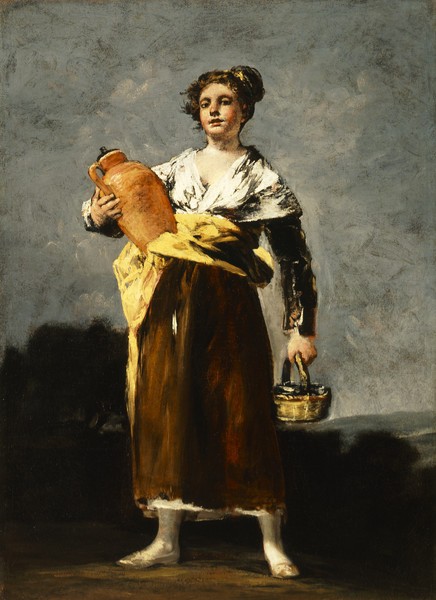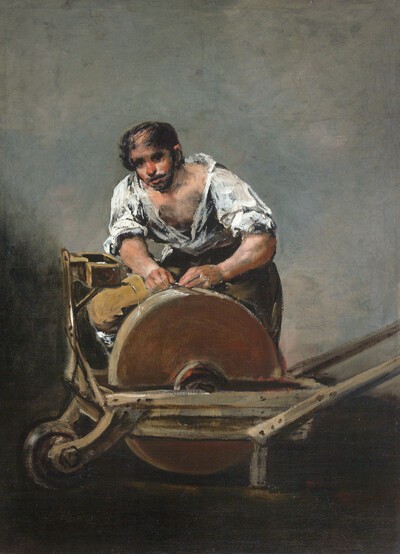- Cronología
- Ca. 1808 - 1812
- Ubicación
- Szépmüvészeti Muzeum. Budapest, Budapest, Hungary
- Dimensiones
- 68 x 52 cm
- Técnica y soporte
- Oil on canvas
- Reconocimiento de la autoría de Goya
- Documented work
- Titular
- Szépmüvészeti Muzeum Budapest
- Ficha: realización/revisión
- 25 Apr 2010 / 13 Jun 2023
- Inventario
- (760)
"A water carrier and its companion painting number thirteen valued at ... 300 [reales]", reads the entry in the 1812 inventory drawn up on the death of Josefa Bayeu. The entry refers to this painting and its pair, which has always been considered to be The Knife Grinder. Gassier and Wilson have expressed their surprise that the painting should be assigned such a high value in the 1812 inventory, given the relatively small size of this pair of paintings. The same valuation is given to Old Women or Time, a larger canvas, meaning that these are the next most expensive paintings in the inventory after the large canvasses Maja and Celestina and Majas on a Balcony. This has led them to the conclusion that perhaps the works housed in the Budapest museum are reductions rather than the original works, although there is no other evidence which backs up this theory. It is more likely that Goya himself put a great value on these paintings which he had almost certainly painted for himself, as can be deduced from their appearance in the inventory, as well as the fact that they were painted over canvasses which had already been used, as x-rays have revealed.
Juliet Wilson is of the opinion that the low point of view used in both works suggests that they were created as overdoors for Goya's Madrid residence in calle Valverde.
Prince Alois Wenzel von Kaunitz-Rietberg, ambassador in Spain and art enthusiast, acquired these two works for his private collection. He later sold them to Prince Nicolas Esterházy, who in turn sold them to the Museum of Fine Arts in Budapest.
The Water Carrier and its companion painting are outstanding examples of genre painting by Goya. They are remarkable works in terms of their modern look and originality: this kind of scene was not usually represented as it is here, against an almost abstract background.
The girl in the image is shown full length, from a low perspective. The pose of the water carrier, dignified, holding a pitcher on her right hip and a basket in her left hand, has classical connotations: the worker is transformed into a heroine, and her figure is exalted against a landscape entirely subordinate to her. This treatment fits in with the interpretation afforded to these two works by critics, who interpret them as a homage to the anonymous heroes of the war against Napoleon. These are not the only works in which Goya remembered his fellow countrymen who fought such a worthy fight at the Sieges of Zaragoza: he also expressed similar sentiments in The Manufacture of Gunpowder and The Manufacture of Bullets. In this case, the painter might have wished to pay tribute to the girls who carried water to the soldiers and offered them encouragement.
This painting is also noteworthy for its colour scheme. The water carrier is wearing a reddish-brown skirt, a white shawl wrapped across her chest, and a large yellow cloth tied around her waist like a sash to support the weight of the pitcher. The colours contrast with each other, and this attractive colour scheme is completed by the orange of the pitcher and greyish-blue of the background.
There is a drawing in Album C, nº 78 which is usually linked to this water carrier. The figure which appears in that piece is similar, although she does not have as heroic an aspect; rather, she is artless and seductive, and might better be associated with the girls in the tapestry cartoon The Water Carriers.
Moreover, there are various existing copies of this work, suggesting that it was much admired, although the authenticity of these works has not been proven. One of these hangs in the Norton Simon Foundation in Fullerton, California. Another is housed in the National Museum of San Carlos in Mexico, which is considered to be a copy by that institution. Finally, there is another in the collection of the Marquis of Montesa in Madrid.
-
Goya and his timesThe Royal Academy of ArtsLondon1963cat. 66cat. 100
-
Spanyol MesterkSzépm?vészeti MúzeumBudapest1965
-
Von Greco bis GoyaHaus der KunstMunich1982From February 20th to April 25th 1982. Exhibited also at the Künstlerhaus, Vienacat. 26
-
Goya y el espíritu de la IlustraciónMuseo Nacional del PradoMadrid1988from October 6th to December 18th 1988. Exhibited also at Museum of Fine Arts, Boston, January 18th to March 26th 1989; The Metropolitan Museum of Art, Nueva York, May 9th to July 16th 1989, Madrid curator Manuela B. Mena Marqués, scientific directors Alfonso E. Pérez Sánchez and Eleanor A. Sayrecat. 68
-
Goya. El Capricho y la Invención. Cuadros de gabinete, bocetos y miniaturasMuseo Nacional del PradoMadrid1993from November 18th 1993 to February 15th 1994. Exhibited also at the Royal Academy of Arts, London, March 18th to June 12th 1994 and The Art Institute of Chicago, Chicago, July 16th to October 16th 1994, consultant editors Manuela B. Mena Marqués and Juliet Wilson-Bareaucat. 93
-
Goya: Prophet der ModerneAlte NationalgalerieBerlin2005from July 13th to October 3th 2005. Exhibitied also at the Kunsthistorischemuseum, Vienna, October 18th 2005 to January 8th 2006, consultant editor Manuela B. Mena Marquéscat. 97
-
Goya en tiempos de guerraMuseo Nacional del PradoMadrid2008consultant editor Manuela B. Mena Marqués, from April 14th to July 13th 2008cat. 67
-
Expérience GoyaLille2021cat. 29
-
Agen2019cat. 16
-
L'œuvre peint de Goya. 4 volsParís1928-1950vol. I, p. 265, cat. 240 NB
-
Vie et ouvre de Francisco de GoyaParísOffice du livre1970pp. 256, 266, cat. 963 y p. 245 (il.)
-
BarcelonaPolígrafa1970vol. I, p. 350, cat. 579
-
L’opera pittorica completa di GoyaMilanRizzoli1974p. 122, cat. 481
-
Francisco de Goya, 4 vols.ZaragozaCaja de Ahorros de Zaragoza, Aragón y Rioja1980-1982vol. III, p. 198 y vol. IV, p. 244 (il.)
-
Goya y el espíritu de la IlustraciónMadridMuseo del Prado1988pp. 260-263, cat. 67 y p. 261(il.)
-
Goya. El capricho y la invención. Cuadros de gabinete, bocetos y miniaturasMadridMuseo del Prado1993pp. 308-310, cat. 93 y p. 311 (il.)
-
Goya en tiempos de guerraMadridMuseo Nacional del Prado2008pp. 256, 258, cat. 67 y p. 2567 (il.)
-
AgenSnoeck2019p. 111
-
Expérience Goya (cat. expo)LilleRéunion des Musées Nationaux2021pp.73-74

